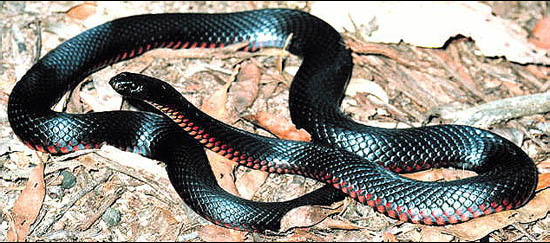[Photo] Red-bellied Black Snake. Photographer: Peter Robertson / Source: Wildlife Profiles Pty. Ltd.
Red-bellied Black Snake
Pseudechis porphyriacus
Identification
The Red-bellied Black Snake, Pseudechis porphyiacus, is a shiny blue-black snake, usually with pink colouring on the lower rows of scales. It has 17 rows of mid-body scales, a divided anal scale and 40???65 subcaudal scales, with single anterior and divided posterior scales. It is a large snake: adults can reach over 2 m.
Distribution and habitat
It is widespread in eastern Victoria; north of the Dividing Range it is often associated with water courses. It is also relatively common in Melbourne’s east and has been recorded around Bacchus Marsh, Park Orchards, Bayswater, along the Plenty River in the South Morang area and around the Merri Creek in the Campbellfield to Somerton area.
Biology and bite
This snake is active both day and night, and its diet consists primarily of frogs. Females can produce in excess of 16 live young.
Although the venom is not as potent as that of other venomous land snakes, this species is still dangerous. If bitten on a limb, apply a pressure bandage, immobilise the limb and seek medical advice immediately. If bitten elsewhere, apply continuous direct pressure to the bite site. Do not wash the wound, as the venom on the skin can be used to identify the appropriate antivenom.
Further reading
Coventry, A. J. and Robertson, P. 1991. The Snakes of Victoria ??? A Guide to their Identification. Department of Conservation & Environment/Museum of Victoria.
Cogger, H. 2000. Reptiles and Amphibians of Australia. Reed Books.
Museum Victoria Information Sheets: Snakes found in Victoria series.
Wilson, S. & Swan, G. 2003. Reptiles of Australia. Princeton University Press.
Internet resources
Bioinformatics website of Museum Victoria:
http://www.museum.vic.gov.au/bioinformatics/snake/
?? Museum Victoria 2000. http://www.museum.vic.gov.au |

